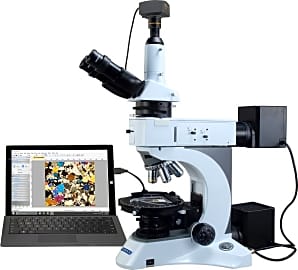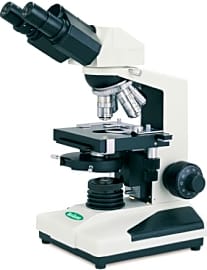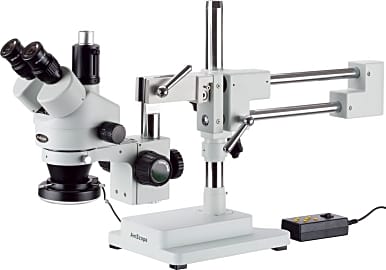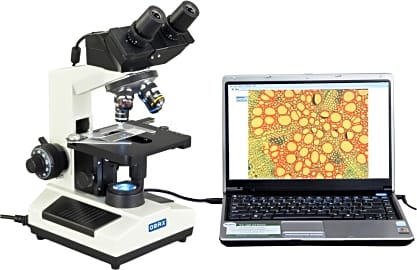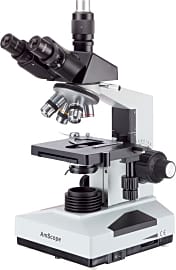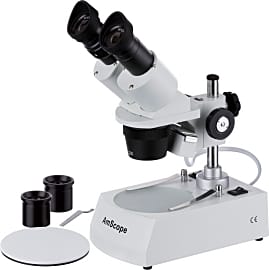The 10 Best Microscopes

This wiki has been updated 47 times since it was first published in February of 2015. Whether you have a budding young scientist in the family or you are a professional researcher or teacher looking for a reliable tool to enhance your work, our comprehensive selection of microscopes is sure to include the perfect model to suit your requirements. We've ranked them here by their special features, magnification power, durability, and included accessories. When users buy our independently chosen editorial recommendations, we may earn commissions to help fund the Wiki.
Editor's Notes
July 30, 2020:
In an effort in increase the quality of the scopes in our selection, we removed a pair of models that were at the lower end of the spectrum in the Dino Lite and the AmScope Compound M158C-E Monocular. The Dino Lite model was just a little too gimmicky, and we wanted our microscopes to be items that could live on a lab table. The Aven Cyclops Digital is a fine alternative to it. And the M158C-E just couldn't compete in camera resolution with other models. At that point, it'd be better to spend the money on a model without imaging capabilities, but with better optics like the Omax Binocular LP-50.
Among the newcomers to our list, you find two extremely high-end offerings, one each from AmScope and Omax. It was a tough decision as to which one was superior, but we went with the AmScope Upright over the Omax Infinity Plan purely on the basis of clarity and optical quality. Bear in mind, however, that the Omax has a higher-resolution sensor in its camera (18MP instead of 6MP), allowing you to crop in much farther on stills and video without losing detail, so if you're in need of high-resolution images you can share, it might be the superior choice for you.
June 04, 2019:
In previous incarnations of this ranking, we hesitated to include some of the higher end models on the market, reasoning that their demographic was too small and their prices were too high. Those prices have come down somewhat, and it's hard to deny the optical superiority of the Amscope and Vanguard models that arrive in our first and third spots, respectively. The ability to utilize phase contrast, brightfield, and darkfield microscopy on that Amscope with such ease and clarity secured it at number one, and it's only the Vanguard's lack of a darkfield option that pushed it back as far as third. The Amscope 144A saw a promotion from last time around, climbing up to our second spot thanks in large part to its versatility and the usefulness of its four-zone LED ring light illumination.
Special Honors
ThermoFisher Scientific Volumescope 2 There aren't a lot of people who require a high-powered electron scanning microscope like this one, but for those who are in need of this kind of power, its ability to render three-dimensional images of cellular architecture makes it an outstanding tool for research and quality control. It maintains an oil-free vacuum chamber with an evacuation time of 3.5 seconds or less. thermofisher.com
Two Magnifiers Are Better Than One
It's probably safe to assume that, at some point in your life, you've used a magnifying glass.
It's probably safe to assume that, at some point in your life, you've used a magnifying glass.
Perhaps you have fond memories of your grandmother struggling to read the small print in her newspaper and reaching for this handy handheld device. Or, maybe you wear those simple reading glasses from the pharmacy.
Then again, maybe you just burned a lot of insects by magnifying the sun.
Whatever your exposure to magnification, the principal applied here is more or less identical to the principal applied in the building of any standard microscope.
You may notice that there are two sets of magnifiers on a microscope.
The first is the objective lens, which is the little tube that points directly at your specimen closest to the stage where the slide is laid. The second is the eyepiece, a longer tube used to further magnify the image coming up through the objective.
There are usually multiple pieces of glass in both the objective and eyepiece, each meant to refine an image to perfection by the time it reaches the final, most important lens: your eye (or a digital image sensor).
Put Your Decision Under, Well, A Microscope
What began as a brilliant but essentially simple invention has advanced at incredible rates, bolstered first by glass cutting and lens-making refinements, and recently by advances in image capturing technology.
So, with all the available bells and whistles, which microscope do you need?
Let me get this out of the way: You don't need an electron microscope. If you did, you wouldn't be researching microscopes online, you'd be arguing over the potential benefits of such a purchase with your fellow PhDs as you built your own evil laboratory cut deep into a mountain in the uncharted territories of northern Russia.
But that still leaves you with a ton of options.
Let me get this out of the way: You don't need an electron microscope.
The easy question? What are you going to look at? That ought to tell you how much magnification you're going to need, which will narrow the field significantly.
The most important question (in my opinion)? How do you want to view your specimen? Binocular microscopes are my preference because I find it more comfortable using both eyes. You might want one eye on your specimen and the other on the notes you're taking. Monocular, then, is right for you.
There's also the question of preservation, and the better imaging specs you can get, the longer it will be before your microscope starts to feel obsolete. These images are the best way to share your findings with colleagues or students, and if they can be captured sharply, or even shown live on a monitor–well, let's just say they won't need a microscope to see the smile on your face.
Finally, there's the question of what's around the corner. Since one of the most expensive part of any microscope is the assembly of finely cut and ground glass elements, removing one or two of those could cut costs. Some of these glass elements exist to bend and straighten light that gets curved during magnification.
So, the advent of the curved image sensor, which Sony's camera R&D departments have patented, would remove the need to straighten out your light. That could both cut down on cost and increase image clarity.
Centuries Of Refinement
In the late 16th century, a pair of Dutch spectacle makers came up with a crude compound microscope with an internal lens at each end. Its magnification was minimal and its images were blurry, but it was the start of something very important.
These are what we refer to today as compound microscopes because the magnifying power of each glass element is compounded by the next.
While magnification had been around for centuries at this point, it was in the combining of lenses that the evolution of the microscope began. These are what we refer to today as compound microscopes because the magnifying power of each glass element is compounded by the next.
The combination and positioning of the glass elements was refined over the centuries, as were the methods for cutting and polishing the glass. This resulted in higher and higher degrees of magnification, and, one can assume, an ever increasing fear of germs (I kid, of course. Germs weren't even suggested until Pasteur's work in the 1860s).
Now, with the advents of LED lighting and smaller camera technology, the need for higher quality optics is giving way to the power of CMOS camera sensors.
In time, the lens elements will likely simplify, or come to resemble camera lenses even more than they do now. But today's combination of sensor and lens technology makes for the highest powered microscopes we could imagine, enlarging our perspective daily.



